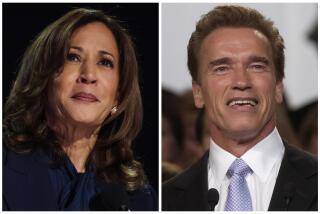Clinton Uses Team Tactics to Plot a Daily Battle Plan : Campaign: A far-flung network forges strategy. It includes lawyers, academics and FOBs--Friends of Bill’s.
- Share via
In the beginning, even before Arkansas Gov. Bill Clinton had irrevocably decided to seek the Democratic presidential nomination, there was the conference call.
It began last summer, modestly enough, with media consultant Frank Greer and pollster Stanley B. Greenberg consulting regularly with Little Rock attorney Bruce Lindsey, a longtime Clinton confidant, and gubernatorial aide Gloria Cabe.
Today, like some transcontinental weed, the morning conference call that plots daily strategy for Clinton’s presidential campaign has grown to encompass a shifting cast of dozens of aides, advisers and friends in at least three and often four or five cities.
“Someone was joking,” said one participant, “that by the time the general election rolls around we’d have a majority of the American people in the conference call.”
That ever-expanding conference call may be the most apt symbol for the campaign that Clinton has assembled around him. Clinton, who by all accounts is his own chief strategist, has built his campaign on the principle that whenever a major decision is on the table, there is always room for another chair.
In practice, that attitude has translated into a campaign organization loose on hierarchy that ventilates broad decisions on strategy and policy through concentric circles of aides and consultants, elected officials and key supporters in each primary state, and, finally, Clinton’s own far-flung network of associates--a group of lawyers, academics and politicians known within the campaign simply as FOBs: Friends of Bill’s.
On paper, it looks like a blueprint for gridlock. But in practice, the Clinton campaign has proved faster on its feet than any of its competitors so far.
“What I like about Clinton is he has a deep, deep distrust of bureaucracy,” says Paul Begala, one of the campaign’s principal strategists. “He does not want a rigid top-down bureaucracy--things can percolate up instead of just edicts being handed down.”
With this vast cast of characters, Clinton has already avoided at least one of the traditional traps for Democratic contenders: relying on an excessively narrow and insular group of like-minded advisers. On any given morning, the group connected across the Clinton campaign’s telephone lifeline is so diverse that it is difficult to imagine them in the same party , much less the same campaign.
Ideologically, they range from Rep. Maxine Waters of Los Angeles to Al From, executive director of the Democratic Leadership Council--a group committed to moving the party away from the brand of fiery liberalism that Waters epitomizes.
And from Los Angeles attorney Mickey Kantor, the silky campaign chairman, to high-strung Louisiana-born chief strategist James Carville, Clinton’s camp accommodates a range of personal styles--from boardroom smooth to Bayou bizarre.
But through it all, the candidate and his team have shown that they share an indivisible sense of the campaign as combat--day by day, hour by hour. “These people play for real,” says Paul Tully, political director at the Democratic National Committee. “That’s a lesson a lot of Republicans are going to understand.”
If anything, some fear, Clinton’s campaign may be too belligerent. At times, the instinct of aides such as Carville to instantly counterpunch has backfired. In New Hampshire, for example, Clinton accused the GOP of orchestrating the controversy about his Vietnam-era draft status by leaking a letter to ABC. But when the network said he was wrong about its source, Clinton had to back away from his charges.
More broadly, even some insiders worry that the campaign’s go-for-the-throat approach to derailing competitors like Paul E. Tsongas has at times almost entirely eclipsed the goal of presenting Clinton in a positive light.
But many Democrats are confident that Clinton’s camp can learn from such mistakes, because it has generally been open to competing viewpoints. Senior aides freely acknowledge they will need more help to plot a general election; if Clinton wins the nomination, sources say, the campaign is likely to offer full-time positions to veterans of previous campaigns such as John Sasso, Michael S. Dukakis’ chief strategist, and Washington attorney Tom Donilon.
Already, the campaign has quietly brought into strategy sessions Democratic consultants such as pollster Mark Mellman. And, Greer says, the campaign is planning to pull together a general election media team with experience in both political and commercial advertising.
For now, the campaign staff largely divides into two spheres: the inside world of senior advisers who maintain a relatively low public profile; and the outside world of “spin doctors” dominated by those who travel with Clinton and his Washington-based consultants. Shadowing both of these groups are the FOBs.
Here’s a quick tour of the upper reaches of Clinton’s campaign--inside, outside and FOBs.
At the pinnacle of the inside team are campaign chairman Kantor and campaign manager David C. Wilhelm. In the campaign’s metaphor of choice, Kantor functions as the organization’s chairman of the board, while Wilhelm operates as the chief executive officer.
Kantor, a 52-year-old Los Angeles attorney in the politically influential firm of Manatt, Phelps, Phillips & Kantor, has known Clinton since the 1970s when he served with Hillary Clinton on the board of directors for the federal Legal Services Corp. A veteran figure in California politics--he ran then-California Gov. Edmund G. (Jerry) Brown Jr.’s 1976 presidential campaign--Kantor’s role dramatically expanded during the tumultuous final weeks before February’s New Hampshire primary.
Since then, Kantor--a calm and ordered mediator--has emerged as the campaign’s first among equals, the one figure capable of deciding when the internal debate is over. “Mickey is kind of the referee on all this,” says pollster Greenberg. “In 90% of the cases there is a consensus, and when there isn’t, he will say, ‘Enough.’ ”
Wilhelm, 35, came on as campaign manager last October. His hiring signaled the importance Clinton placed on the Illinois contest. A Chicago-based political consultant, Wilhelm had managed campaigns for Chicago Mayor Richard M. Daley, and his contacts helped Clinton build the formidable organization that swept him to victory in the state last month.
Wilhelm has focused less on the campaign’s broad message than on setting its day-by-day priorities--supervising the schedule, field, finance, and political liaison operations and making the cuts on how much time and effort Clinton devotes to each primary contest.
Even less visible than Wilhelm has been senior adviser Mark Gearan, the executive director of the Democratic Governors Assn. Gearan, 35, played a key role in running Clinton’s New Hampshire operation, and has since assumed major responsibilities for coordinating the development of the campaign’s media and message.
Also keeping a low profile is Bruce Reed, the campaign’s 32-year-old policy director. Formerly policy director at the Democratic Leadership Council, Reed drafts Clinton’s major addresses and coordinates outside advisers, such as
Robert Shapiro, a vice-president of the Progressive Policy Institute who counsels Clinton on economic issues, and Anthony Lake, a former State Department official who has emerged as the campaign’s “unofficial coordinator” on foreign policy.
Many insiders consider Rahm Emmanuel, the 32-year-old finance director, the campaign’s most indispensable figure, because of his ability to keep the money flow uninterrupted even as Clinton was rocked by the allegations of marital infidelity and draft-dodging before the New Hampshire primary.
Further back yet in the inner reaches of the Clinton campaign is Massachusetts businessman Eli J. Segal. Segal, a veteran of presidential campaigns by George S. McGovern and Gary Hart, has received almost no publicity--but he played the key role in hiring the staff that has brought Clinton this far and is likely to be given responsibility for staffing the general election campaign.
The most visible members of the outside team are strategists James Carville and Paul Begala, and deputy campaign manager George Stephanopoulos. Together with press secretary Dee Dee Myers, 30, all three regularly travel with Clinton and take primary responsibility for arguing the campaign’s case to the traveling press--or “spinning” them.
But Carville, Begala and Stephanopoulos also wield influence across a broad range of strategic considerations. “If you were drawing an organizational chart,” says one senior figure, “you would put them off to the side but in the middle of everything.”
Along with Reed, Stephanopoulos, 31, is the principal repository of Clinton’s views on almost any issue. A former floor assistant for House Majority Leader Richard A. Gephardt (D-Mo.), he seems to emerge at the center of any crisis confronting the campaign.
Carville, 47, and Begala, 30, have worked together as consultants since 1984, but they made their name last year by masterminding Democrat Harris Wofford’s stunning come-from-behind Senate race victory over former Atty. Gen. Dick Thornburgh in Pennsylvania. Mild-mannered by comparison to his partner, Begala is a gifted phrase maker. Sources say he penned the fierce attack that Georgia Gov. Zell Miller launched at Tsongas the morning after the New Hampshire primary.
Carville may be the purest embodiment of the campaign’s pugnacious nature. As a strategist, he views politics as an unremitting war--not only with the other candidates, but with the media, for control of the daily agenda. With his good-ol’-boy manner, he reminds some people of the late Republican strategist Lee Atwater; when he’s raging full-throated against the latest media gale buffeting the campaign, he reminds others of Ahab in obsessive pursuit of Moby Dick.
If Carville is the campaign’s most voluble member, the most contained may be campaign director Bruce R. Lindsey, a 43-year-old Little Rock attorney who functions as a discreet counselor for Clinton. Bev Lindsey, his wife, directs Clinton’s schedule.
One of the pivotal figures in the development of Clinton’s message is pollster Stanley B. Greenberg. A former Yale University political scientist, Greenberg, 46, has influenced Democratic thinking over the last decade through his studies of the middle-class squeeze, voter fears of economic decline and the role of race in the sundering of the New Deal coalition.
An Alabama native, media consultant Frank Greer, 45, shares with Clinton the experience of growing up in the segregated South and a bent for sharp-edged populist politics. In designing the ads, Greer works with his partner, Mandy Grunwald, and associate Anne Lewis as well as a message group that includes Greenberg, Wilhelm, Kantor, Gearan, Begala and Carville.
Beyond these circles loom Clinton’s network of FOBs, who regularly fax in memos on just about everything. Among the FOBs, those with the busiest keyboards include Derek Shearer, a professor of government at Occidental College in Los Angeles; television producers and native Arkansans Harry and Linda Bloodworth-Thomason, the creators of “Designing Women”; Ira Magaziner, a business strategy consultant and author from Rhode Island, and Robert Reich, a political economist at Harvard University.
At the end of all these lines is Clinton--a candidate as conversant with the latest trends in policy and political strategy as his consultants. For all the firepower assembled around him, none of those in Clinton’s orbit doubts that he retains final control over his course toward the prize that has mesmerized him since he was a teen-ager.
“We’re all senior advisers to a candidate who doesn’t seem to need us in many respects,” said one senior adviser. “We all have things to do--there is always work to be done, but it isn’t clear that strategy is really a part of that.”
Times staff writer Paul Richter contributed to this story.
More to Read
Get the L.A. Times Politics newsletter
Deeply reported insights into legislation, politics and policy from Sacramento, Washington and beyond. In your inbox three times per week.
You may occasionally receive promotional content from the Los Angeles Times.










